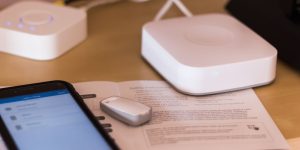Setup a Smart Home Hub
If you’re going all-in on smart home tech, you might want to invest in a hub. These devices act as the brains of your home automation system, connecting all your other gadgets and allowing you to control them from one place — usually via voice or an app. But not all smart home hubs are created equal, and finding the right one can be tricky. To help you, we spoke to Sumi Helal, a professor of computer and information science and engineering at the University of Florida and director of the Gator-Tech Smart House, who shared her top picks. These highly rated smart home hubs are great options for people who need an easy way to link up their devices.
Smart hubs connect to devices through a wireless protocol, such as Z-Wave and Zigbee. These protocols allow devices to communicate directly with each other, without using your Wi-Fi network and potentially slowing down your Internet speed. They’re also more stable than Wi-Fi connections, which can experience outages and be susceptible to interference from other gadgets in your home.

Consider the brand of smart home hub devices you own and what other technologies they use, such as voice assistants like Alexa, Siri or Google Assistant and if they integrate with other apps, such as IFTTT (If This Then That). You should also look at the smart hub’s compatibility with a variety of devices from different manufacturers and its operating system compatibility, since there can be variations between the systems used by different devices.
How to Setup a Smart Home Hub
The most popular smart home hub is Samsung’s SmartThings platform, which has been around for a long time and supports most major smart home brands. It’s backed by a large company and offers a good balance of features and affordability. The SmartThings ecosystem is growing and the company has a strong track record in customer support.
Another option is Home Assistant, an open source platform that runs locally and can be installed on a Raspberry Pi. This is more for tech-savvy people but can handle almost any automation imaginable. However, it doesn’t always work as well with some smart home devices and can take up a lot of your time to set up.
Once you’ve decided on a smart home hub, it should come with a set of instructions for getting it up and running. Read through the entire setup process and follow all the prompts. If you run into trouble, consult the manufacturer’s website for troubleshooting assistance and search YouTube for how-to videos. After completing the initial setup, you should see the hub LED turn a solid green and the SmartThings IDE and app display your devices.
If the SmartThings hub doesn’t complete its setup after a few minutes, you can reset it by unplugging it, waiting 1 minute, then plugging it back in. If the LED is still blinking blue, check the SmartThings status webpage and make sure its cloud connection is functioning. If it isn’t, try changing the connection from WiFi to Ethernet and wait 2 minutes before trying again.
